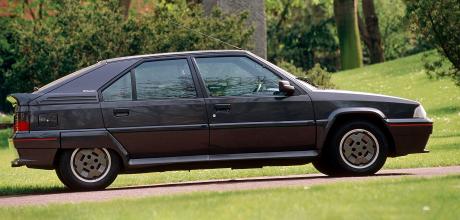Buying Guide Citroen BX 16 Valve

Characterful yet cool, quick yet suave — and as French as they come
THE MARKET / Buying Guide
How does the Lamborghini designer get to Lamborghini? It was a question asked and answered by Citroens clever ad department in the late 1980s, making a feature of the fact that the man responsible for styling the Countach, Marcello Gandini, chose a BX 16 Valve as his daily driver.

In a class filled with conservative family cars, the BX was a real breath of fresh air. It was launched in 1982, an innovative car that combined Citroens hydropneumatic suspension with more conventional (and reliable) Peugeot-based mechanicals. Clever use of materials kept weight low, while its straight-edge Bertone style gave it a unique identity.
While making a sporty version of a hydropneumatic Citroen might not seem particularly logical, even the basic models were responsive and fun to drive. Early efforts were promising, with the 8-valve GT and GTI offering tidy handling and swift performance thanks to low weight. The ultimate performance BX (let’s not mention the Group B 4TC) was launched in March 1987 as the GTI 16v.
The mechanical package of the 16v wasn’t drastically different to any other BXs. A set of slightly firmed-up suspension spheres and wider tyres improved the handling, and a full-on 1980s-style bodykit — front spoiler, side-skirts and high-rise rear spoiler — gave it a more aggressive look. The very heart and soul of the 16v, as the name suggests, lives under the plastic bonnet. It’s an all-alloy 1.9-litre 16-valve engine, producing 160bhp and 133lb ft. Although related to the family of 8-valve XU engines found throughout the PSA range (including the 205 GTI), this version’s 205 T16-derived cylinder head made it a real thoroughbred. Citroen claimed 0-60mph in 7.4sec and a top speed of 135mph, but you had to work it hard to achieve those numbers.
By 1988 the GTI name had been dropped in favour of ‘16 Valve’ badging. Towards the end of 1989 the range received a facelift, with lots of detail spec changes and, most noticeably, a pair of smoked rear light lenses. The 16 Valve was given a more thorough visual update, giving these ‘Phase 2’ models a whole new look. The moulded plastic bumpers were replaced with deeper glassfibre items, and the high- rise rear spoiler was changed for a sleeker ducktail type. The wheels were also painted in anthracite with a diamond-cut lip. From mid-1992, UK cars were fitted with a catalytic converter, which knocked 10bhp off the peak power output. Production came to an end in 1993.
Finding a good 16 Valve today is not impossible, but the majority are in the tight grip of long-term enthusiasts. Project cars are out there, but these can be a lot of work. Parts availability has always been a bit hit-and-miss, but companies such as Chevronics in the UK are now re-making many vital components.
Although it went through a period of being seen as a cheap Peugeot 205 ‘Mi16’ engine donor, which killed many good cars, the lovable character of the BX 16v has ensured that a decent number have survived. Prices have increased a lot in the past few years, but it’s still a great buy.
THE LOWDOWN
WHAT TO PAY
- Expect to pay around £1500 for a viable project these days. Budget between £2500 and £3500 for a running and driving car, up to about £6500 for one of the best, although exceptional examples with low miles are potentially worth upwards of £10,000. Prices are generally higher in Europe.
- Phase 2 models tend to be more sought after, but Phase 1s are rarer so there's not too much variation in the values — it's all about condition.
WHAT TO LOOK OUT FOR
- Very tidy-looking cars can hide terminal rust underneath. Inspect the rear chassis legs, subframe mounts and the boot floor — especially around the exhaust hanger. The A-posts can rot, especially around the door hinges, as does the area under the washer bottles.
- If maintained, the engines are very reliable. A lumpy idle is normal, but make sure it pulls cleanly (and strongly) to the 7000rpm redline.
- The hydraulics are simple and reliable if maintained by a specialist. Check for leaks, clean fluid and a smooth ride.

